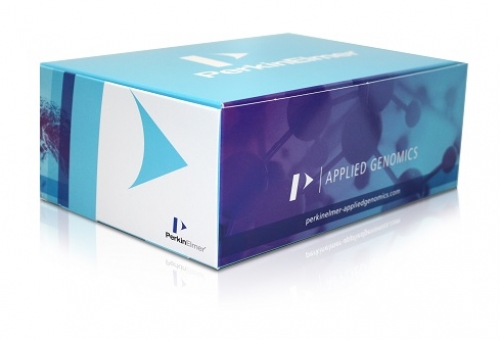
NEXTFLEX® 16S V1-V3 Amplicon-Seq Kit
Optimized protocol offers lower PCR bias and fewer off-target reads
Fast library prep protocol
Low input – As low as 1 ng of genomic DNA
- Product description
- Kit Contents
- Citations
Preparation of Multiplexed Amplicon Libraries
The NEXTFLEX® 16S V1 – V3 Amplicon-Seq Library Prep Kit is designed for the preparation of multiplexed amplicon libraries that span the hypervariable domains one through three (V1-V3) of microbial 16S ribosomal RNA (rRNA) genes. These libraries are compatible with paired-end sequencing on the Illumina® sequencing platforms.
Fast Library Prep Protocol
There are two main steps involved in 16S V1-V3 amplicon processing: an initial PCR amplification using customized PCR primers that target the V1-V3 domains, and a subsequent PCR amplification that integrates relevant flow cell binding domains and unique 12 base pair sample indices. The limited number of cleanup steps ensures maximum recovery of amplicons for downstream sequencing.
Optimized Protocol Offers Lower PCR Bias and Fewer Off-target Reads
The protocol incorporated in the NEXTFLEX 16S V1 – V3 Amplicon-Seq Kit offers better sequencing results than can be obtained using traditional 16S sequencing protocols. The incorporation of the second PCR step in the protocol for the addition of the sample-specific index reduces the number of off-target reads typically encountered during amplicon sequencing.
Automate your 16S V1 – V3 Library Prep to Increase Throughput and Reduce Errors
A NEXTFLEX® automation protocol is now available on the Sciclone® NGS and NGSx workstations to help labs increase their throughput and reduce human errors. Automated versions of the NEXTFLEX® 16S V1 – V3 Amplicon-Seq Library Prep kits are available by request.
Features
Optimized protocol offers lower PCR bias and fewer off-target reads
Fast library prep protocol
Low input – As low as 1 ng of genomic DNA
Flexible barcode options– Up to 384 unique barcodes available for multiplexing of libraries
Does not require custom sequencing primers
Automation protocols are now available for the PerkinElmer Sciclone® NGS and NGSx Workstations to automate your 16S sequencing
Functionally validated on the Illumina® MiSeq® sequencer
Kit Specs
| Cat # | Name | Quantity |
| NOVA-4202-02 | NEXTflex™ 16S V1-V3 Amplicon-Seq Kit (12 Barcodes) | 24 RXNS |
| NOVA-4202-03 | NEXTflex™ 16S V1-V3 Amplicon-Seq Kit (48 Barcodes) | 96 RXNS |
| NOVA-4202-04 | NEXTflex™ 16S V1-V3 Amplicon-Seq Kit (Barcodes 1-96) | 192 RXNS |
| NOVA-4202-05 | NEXTflex™ 16S V1-V3 Amplicon-Seq Kit (Barcodes 97-192) | 192 RXNS |
| NOVA-4202-06 | NEXTflex™ 16S V1-V3 Amplicon-Seq Kit (Barcodes 193-288) | 192 RXNS |
| NOVA-4202-07 | NEXTflex™ 16S V1-V3 Amplicon-Seq Kit (Barcodes 289-384) | 192 RXNS |
KIT CONTENTS
NEXTFLEX® PCR Master Mix
NEXTFLEX® 16S V1-V3 PCR I Primer Mix
NEXTFLEX® PCR II Barcoded Primer Mix
Resuspension Buffer
Nuclease-free Water
REQUIRED MATERIALS NOT PROVIDED
1 ng – 50 ng high-quality genomic DNA in up to 36 µL nuclease-free water for each library
96 well PCR Plate Non-skirted (Phenix Research, Cat # MPS-499) or similar
Adhesive PCR Plate Seal (Bio-Rad®, Cat # MSB1001)
Agencourt® AMPure® XP 5 mL (Beckman Coulter® Genomics, Cat # A63880)
Magnetic Stand – 96 (Thermo Fisher® Scientific, Cat # AM10027) or similar
Thermocycler
2, 10, 20, 200 and 1000 µL pipettes / multichannel pipettes
Nuclease-free barrier pipette tips
Vortex
80% Ethanol, freshly prepared (room temperature)
Selected Citations that Reference the Use of the NEXTFLEX 16S V1-V3 Amplicon-Seq Kit
Cortez, V., Canal, E., Dupont-Turkowsky, J. C., Quevedo, T., Albujar, C., Chang, T., . . . Bausch, D. G. (2018). Identification of Leptospira and Bartonella among rodents collected across a habitat disturbance gradient along the Inter-Oceanic Highway in the southern Amazon Basin of Peru. Plos One, 13(10). doi:10.1371/journal.pone.0205068.
Franzen, J., Zirkel, A., Blake, J., Rath, B., Benes, V., Papantonis, A., & Wagner, W. (2016). Senescence-associated DNA methylation is stochastically acquired in subpopulations of mesenchymal stem cells. Aging Cell, 16(1), 183-191. doi:10.1111/acel.12544.
Hakim, H., Dallas, R., Wolf, J., Tang, L., Schultz-Cherry, S., Darling, V., . . . Rosch, J. W. (2018). Gut Microbiome Composition Predicts Infection Risk During Chemotherapy in Children With Acute Lymphoblastic Leukemia. Clinical Infectious Diseases,67(4), 541-548. doi:10.1093/cid/ciy153.
Luna, R. A., Oezguen, N., Balderas, M., Venkatachalam, A., Runge, J. K., Versalovic, J., . . . Williams, K. C. (2017). Distinct Microbiome-Neuroimmune Signatures Correlate With Functional Abdominal Pain in Children With Autism Spectrum Disorder. Cellular and Molecular Gastroenterology and Hepatology, 3(2), 218-230. doi:10.1016/j.jcmgh.2016.11.008.
Maiuri, A. R., et al. (2017) Mismatch Repair Proteins Initiate Epigenetic Alterations during Inflammation-Driven Tumorigenesis. Cancer Research, 77(13), 3467-3478. doi:10.1158/0008-5472.can-17-0056.
Quereda, J. J., et al. (2016) Bacteriocin from epidemic Listeria strains alters the host intestinal microbiota to favor infection. PNAS. doi:10.1073/pnas.1523899113.
Pahwa, R., Balderas, M., Jialal, I., Chen, X., Luna, R. A., & Devaraj, S. (2017). Gut Microbiome and Inflammation: A Study of Diabetic Inflammasome-Knockout Mice. Journal of Diabetes Research,2017, 1-5. doi:10.1155/2017/6519785.
Ranjan, R., Rani, A., Metwally, A., McGee, H. S. and Perkins D. L. (2015) Analysis of the microbiome: Advantages of whole genome shotgun versus 16S amplicon sequencing. Biochem Biophy Res Com. doi:10.1016/j.bbrc.2015.12.083.
Su, A., Yang, W., Zhao, L., Pei, F., Yuan, B., Zhong, L., . . . Hu, Q. (2018). Flammulina velutipes polysaccharides improve scopolamine-induced learning and memory impairment in mice by modulating gut microbiota composition. Food & Function, 9(3), 1424-1432. doi:10.1039/c7fo01991b.
Whon, T. W., Chung, W., Lim, M. Y., Song, E., Kim, P. S., Hyun, D., . . . Nam, Y. (2018). The effects of sequencing platforms on phylogenetic resolution in 16 S rRNA gene profiling of human feces. Scientific Data, 5, 180068. doi:10.1038/sdata.2018.68.
Yao, J. et al. (2016) A Pathogen-Selective Antibiotic Minimizes Disturbance to the Microbiome. Antimicrob. Agents Chemother. 00535-16. doi:10.1128/AAC.00535-16.








